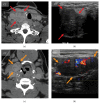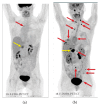Medullary Thyroid Carcinoma: An Update on Imaging
- PMID: 31360432
- PMCID: PMC6642782
- DOI: 10.1155/2019/1893047
Medullary Thyroid Carcinoma: An Update on Imaging
Abstract
Medullary thyroid carcinoma (MTC), arising from the parafollicular C cells of the thyroid, accounts for 1-2% of thyroid cancers. MTC is frequently aggressive and metastasizes to cervical and mediastinal lymph nodes, lungs, liver, and bones. Although a number of new imaging modalities for directing the management of oncologic patients evolved over the last two decades, the clinical application of these novel techniques is limited in MTC. In this article, we review the biology and molecular aspects of MTC as an important background for the use of current imaging modalities and approaches for this tumor. We discuss the modern and currently available imaging techniques-advanced magnetic resonance imaging (MRI)-based techniques such as whole-body MRI, dynamic contrast-enhanced (DCE) technique, diffusion-weighted imaging (DWI), positron emission tomography/computed tomography (PET/CT) with 18F-FDOPA and 18F-FDG, and integrated positron emission tomography/magnetic resonance (PET/MR) hybrid imaging-for primary as well as metastatic MTC tumor, including its metastatic spread to lymph nodes and the most common sites of distant metastases: lungs, liver, and bones.
Figures











Similar articles
-
F-18-Dopa Positron Emission Tomography/Computed Tomography Is More Sensitive Than Whole-Body Magnetic Resonance Imaging for the Localization of Persistent/Recurrent Disease of Medullary Thyroid Cancer Patients.Thyroid. 2019 Oct;29(10):1457-1464. doi: 10.1089/thy.2018.0351. Thyroid. 2019. PMID: 31530235
-
Positron emission tomography (18FDG-PET) in the detection of medullary thyroid carcinoma metastases.Endokrynol Pol. 2006 Jul-Aug;57(4):452-5. Endokrynol Pol. 2006. PMID: 17006852
-
The role of 18F-FDG PET/CT in detecting metastatic deposits of recurrent medullary thyroid carcinoma: a prospective study.Eur J Surg Oncol. 2008 May;34(5):581-6. doi: 10.1016/j.ejso.2007.08.005. Epub 2007 Sep 24. Eur J Surg Oncol. 2008. PMID: 17892923
-
A Comprehensive Comparison of CT, MRI, Positron Emission Tomography or Positron Emission Tomography/CT, and Diffusion Weighted Imaging-MRI for Detecting the Lymph Nodes Metastases in Patients with Cervical Cancer: A Meta-Analysis Based on 67 Studies.Gynecol Obstet Invest. 2017;82(3):209-222. doi: 10.1159/000456006. Epub 2017 Feb 10. Gynecol Obstet Invest. 2017. PMID: 28183074 Review.
-
Role of 18F-FDG-PET and PET/CT imaging in thyroid cancer.Biomed Pharmacother. 2006 Sep;60(8):409-13. doi: 10.1016/j.biopha.2006.07.008. Epub 2006 Aug 1. Biomed Pharmacother. 2006. PMID: 16891093 Review.
Cited by
-
miR‑592 acts as an oncogene and promotes medullary thyroid cancer tumorigenesis by targeting cyclin‑dependent kinase 8.Mol Med Rep. 2020 Oct;22(4):3316-3326. doi: 10.3892/mmr.2020.11392. Epub 2020 Jul 30. Mol Med Rep. 2020. PMID: 32945439 Free PMC article.
-
Medullary Thyroid Carcinoma: A Single Institute Experience.Indian J Otolaryngol Head Neck Surg. 2023 Dec;75(4):2884-2889. doi: 10.1007/s12070-023-03867-2. Epub 2023 May 22. Indian J Otolaryngol Head Neck Surg. 2023. PMID: 37974849 Free PMC article.
-
Does the extent of neck surgery based on preoperative calcitonin level influence survival in medullary thyroid carcinoma: a retrospective tertiary centre experience.Ann R Coll Surg Engl. 2025 Mar;107(3):199-205. doi: 10.1308/rcsann.2024.0033. Epub 2024 Apr 25. Ann R Coll Surg Engl. 2025. PMID: 38661438 Free PMC article.
-
FAPi-Based Agents in Thyroid Cancer: A New Step towards Diagnosis and Therapy? A Systematic Review of the Literature.Cancers (Basel). 2024 Feb 19;16(4):839. doi: 10.3390/cancers16040839. Cancers (Basel). 2024. PMID: 38398230 Free PMC article. Review.
-
Imaging medullary thyroid cancer patients with detectable serum markers: state of the art and future perspectives.Endocrine. 2022 Feb;75(2):330-337. doi: 10.1007/s12020-021-02930-8. Epub 2021 Nov 8. Endocrine. 2022. PMID: 34748168 Review.
References
Publication types
Grants and funding
LinkOut - more resources
Full Text Sources

